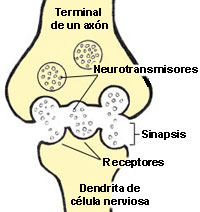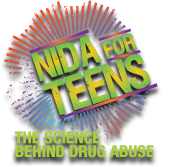
No matter how Methamphetamine is used, it eventually ends up in the bloodstream where it is circulated throughout the brain. Methamphetamine can affect lots of brain structures, but the ones it affects the most are the ones that contain a chemical called dopamine. The reason for this is that the shape, size, and chemical structure of Methamphetamine and dopamine are similar. Before I tell you more about dopamine and Methamphetamine, I'd better tell you how nerve cells work.
Your brain is made up of billions of nerve cells (or neurons). Neurons come in all shapes and sizes, but most have three important parts: a cell body that contains the nucleus and directs the activities of the neuron; dendrites, short fibers that receive messages from other neurons and relay them to the cell body; and an axon, a long single fiber that carries messages from the cell body to dendrites of other neurons.
Axons of one neuron and the dendrites of a neighboring neuron are located very close to each other, but they don't actually touch. Therefore, to communicate with each other they use chemical messengers known as neurotransmitters. When one neuron wants to send a message to another neuron it releases a neurotransmitter from its axon into the small space that separates the two neurons. This space is called a synapse. The neurotransmitter crosses the synapse and attaches to specific places on the dendrites of the neighboring neuron called receptors. Once the neurotransmitter has relayed its message, it is either destroyed or taken back up into the first neuron where it is recycled for use again.
There are many different neurotransmitters, but the one that is most affected by Methamphetamine is dopamine. Dopamine is sometimes called the pleasure neurotransmitter because it helps you feel good from things like playing soccer, eating a big piece of chocolate cake, or riding a roller coaster. When something pleasurable happens, certain axons release lots of dopamine. The dopamine attaches to receptors on dendrites of neighboring neurons and passes on the pleasure message. This process is stopped when dopamine is released from the receptors and pumped back into the neuron that released it where it is stored for later use.




